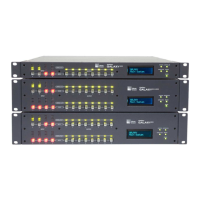GALILEO GALAXY USER GUIDE
39
Channel Settings
Under the Channel Settings tab in Input Processing (see Figure 17, lower half), the user can set a Label, Gain value, Delay
Value, Mute the Channel, and enable or bypass Parametric, U-Shaping, and/or all EQ for a particular input channel. Select
the Input Channel to control via the drop-down menu or individual alphabetic channel buttons (e.g., A-H for a GALAXY 816
processor) above the plotter display.
• The Label widget allows a user to enter a short text description of a Channel, Array Group, or Link Group. It is for
informational purposes only.
• The Gain widget lets the user increase or decrease the signal level by decibels (dB). The default assumes negative gain
values. Entering any integer will result in the gain being set to the negative of that integer (e.g., “3” becomes -3 dB gain).
(The default may be changed to positive gain values in the Compass Preferences tab.)
• The Delay widget allows the user to add a delay in various units to an input channel or matrix input signal. The range is
0–500 ms.
• Clicking the input channel Mute button prevents any signal from being sent to the Matrix.
• Clicking the Select button causes this channel to be linked to other input channels that are also selected. Changes made
to one selected channel will be made to all other selected channels of the same type (input or output) of a device.
Depending on the Global Linking Preferences, channels on other devices may be affected as well. Use Link Groups to
quickly select or deselect multiple channels. Selected channels have a green background.
• Use the Isolate button to temporarily isolate a channel from other channels to which it is linked. Isolating a channel will
change its background color to amber.
• Use the Link Groups button to edit multiple channels simultaneously. The Link Groups tab is also accessible from this
pop-up menu. The Link Group to which a channel belongs is indicated by the number next to “LG.” Link Group index
buttons are blue when enabled, yellow when bypassed, and gray when not in use. Channels in active link groups may
have a blue background, depending on the Link Groups and Selects mode.
• The Parametric EQ Bypass button allows the user to bypass Parametric EQ for an input channel without affecting the
individual Parametric Band Bypass settings.
• The U-Shaping Bypass button allows the user to bypass the U-Shaping EQ filter on a GALAXY processor input channel.
• The EQ Bypass button allows the user to bypass all input Equalization filters while leaving filter-specific EQ bypass
settings alone.
Parametric
Parametric controls may be set via a tab in the lower half of the Input Processing tab (Figure 18). Input Parametric EQ has 5
bands. Each band has four settings: Bypass, Frequency, Bandwidth and Gain.
• Bypass allows the user to bypass an individual parametric EQ band for that channel.
• Frequency allows the user to adjust the central frequency of a parametric EQ band. The Frequency range is
10 Hz – 20 kHz. When entering a value, the Hz suffix is optional. A value can be entered in a number of ways. For
example, 1500 Hz may be entered as 1.5 k, 1k5, and 1500.
• Bandwidth size sets the range of frequencies that are affected by band gain changes. The Bandwidth range is 0.1–2.0.
When the Bandwidth is “1,” the handles span one octave. Setting it to “2” means the handles span two octaves.
• Gain allows the user to adjust the gain of a parametric EQ band. The Gain range is -18 dB to +18 dB.

